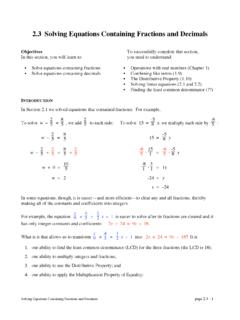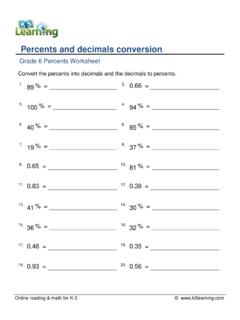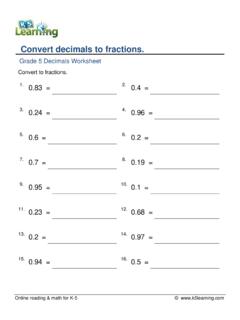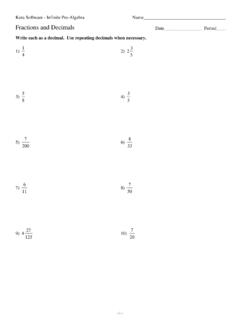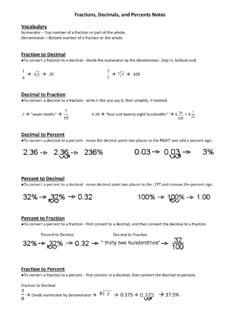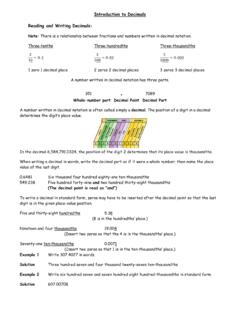Transcription of 2.3 Solving Equations Containing Fractions and Decimals
1 Solving Equations Containing Fractions and Decimals Objectives To successfully complete this section, In this section, you will learn to: you need to understand: Solve Equations Containing Fractions Operations with real numbers (Chapter 1). Solve Equations Containing Decimals Combining like terms ( ). The Distributive Property ( ). Solving linear Equations ( and ). Finding the least common denominator (??). INTRODUCTION. In Section we solved Equations that contained Fractions . For example, 2 8 2 -5 -8. To solve w 5 = 5 , we add 5 to each side: To solve 15 = 8 y, we multiply each side by 5 : 2 8 -5. w 5 = 5 15 = 8 y 2 2 8 2 -8 15 -8 -5. w 5 + 5 = 5 + 5 5 1 = 5 8 y 10 -8 3. w + 0 = 5 1 1 = 1y w = 2 -24 = y y = -24. In some Equations , though, it is easier and more efficient to clear any and all Fractions , thereby making all of the constants and coefficients into integers. x 4 1. For example, the equation 9 + 3 = 2 x 1 is easier to solve after its Fractions are cleared and it has only integer constants and coefficients: 2x + 24 = 9x 18.
2 X 4 1. What is it that allows us to transform 9 + 3 = 2 x 1 into 2x + 24 = 9x 18? It is 1. our ability to find the least common denominator (LCD) for the three Fractions (the LCD is 18);. 2. our ability to multiply integers and Fractions ;. 3. our ability to use the Distributive Property; and 4. our ability to apply the Multiplication Property of Equality: Solving Equations Containing Fractions and Decimals page - 1. The Multiplication Property of Equality We may multiply any non-zero number, c, to each side of an equation. If a = b, then c a = c b, c 0. x 4 1. Applying the Multiplication Property of Equality to an equation such as 9 + 3 = 2 x 1 requires that we first prepare the equation by grouping each side as one quantity, using parentheses: x 4 1. 9 + 3 = (2 x 1). It is then that we can apply the Multiplication Property of Equality and multiply each side by 18: x 4 1. 18 9 + 3 = 18 2 x 1( ). The Solving of this equation will be completed later in this section.
3 To learn the process, let's start with some simpler Equations . Equations Containing Fractions . 3. Let us start with an equation that contains just one fraction, 2x 1 = 4 x + 9. It is possible to solve this 3. equation by first adding -4 x to each side, but to avoid the time-consuming work involved with Fractions , it is often helpful to first clear the fraction or clear the denominator and work only with integers. Caution: Clearing the Fractions requires us to multiply each full side of the equation each and every term by the same value, the common denominator. We do not multiply only the terms Containing Fractions . ~Instructor Insight To this point, students have never been asked to create their own parentheses, so this extra step of preparation is introduced. After Example 1, it will become part of the multiplication step. As stated above, and as shown in Example 1, we must prepare the 3. equation for multiplication by grouping each side using parentheses: (2x 1) = (4 x + 9).
4 Solving Equations Containing Fractions and Decimals page - 2. Example 1: Solve this equation by first clearing the fraction(s). 3. 2x 1 = 4 x + 9. Procedure: There is only one fraction. Multiply each side by 4 to clear the fraction. 3 The LCD is 4. Prepare the equation by placing Answer: 2x 1 = 4 x + 9 parentheses around each side. 3. (2x 1) = (4 x + 9) Multiply each side by 4. Distribute 4, on each side, to each term. To multiply 4. 3. 4(2x 1) = 4 ( 4x +9) 3 4. to the fraction 4 x, it is helpful to write 4 as 1. 4 3 4 3. 4 2x 4 1 = 1 4 x + 4 9 1 4 x simplifies to 3x. Reduce this to standard form 8x 4 = 3x + 36 by adding -3x to each side. Verify the solution, 8: 3. 8x + (-3x) 4 = 3x + (-3x) + 36 Simplify each side. 2x 1 = 4 x + 9. Isolate the variable term by ? 3. 5x 4 = 36 adding +4 to each side. 2(8) 1 = 4 (8) + 9. ? 3 8. 5x 4 + 4 = 36 + 4 Simplify each side. 16 1 = 4 1 +9. ? 3 2. 5x = 40 Divide each side by 5. 15 = 1 1 +9.
5 5x 40 ? 5 = 5 Simplify. 15 = 6+9. x =8 15 = 15 . Note: The two steps of 1. preparing the equation for multiplication by placing parentheses around each side, and 2. showing the multiplication by the LCD. can be combined into one step, just as they are in the next example. Solving Equations Containing Fractions and Decimals page - 3. If an equation contains more than one fraction, then to clear all Fractions , we must multiply by the least common denominator (LCD) of all the denominators. If the Fractions already have a common denominator, then we multiply each side by that common denominator, as shown in Example 2. Example 2: Solve this equation by first clearing the Fractions . 3w 9. 2 +1=w+2. Procedure: There is only one denominator, 2. Multiply each side by 2 to clear the Fractions . 3w 9 The LCD is 2. Prepare the equation by placing Answer: 2 +1= w+2 parentheses around each side. Multiply each side by 2. 3w 9 Distribute 2, on each side, to each term.
6 2 2 + 1 = 2 w + 2 2. Write 2 as 1 when multiplying the Fractions 2 3w 2 9 2 3w 2 9. 1 2 +2 1 = 2 w+1 2 1 2 simplifies to 3w; 1 2 simplifies to 9. Reduce this to standard form 3w + 2 = 2w + 9 by adding -2w to each side. Verify the solution, 7: 3w 9. 3w + (-2w) + 2 = 2w + (-2w) + 9 Simplify each side. 2 +1 = w+2. Isolate the variable term by 3(7) ? 9. w+2= 9 adding -2 to each side. + 1 = 7+2. 2. 21 2 ? 14 9. w + 2 + (-2) = 9 + (-2) Simplify. =. 2 +2 2 +2. w = 7 23 23. 2 = 2 . Solving Equations Containing Fractions and Decimals page - 4. YTI 1 Solve each equation by first clearing the Fractions . Verify the solution. Use Examples 1 and 2 as guides. x 4. a) 3 =x+4 b) m 3=5 m 2. x 2x 1 3w c) 5 4=2 5 d) 2 +w = 8 2. Fractions WITH DIFFERENT DENOMINATORS. If the denominators are different, we must identify the LCD before we multiply. Then, to clear the Fractions , we must multiply each side by the LCD. Solving Equations Containing Fractions and Decimals page - 5.
7 Example 3: Solve each equation by first clearing the Fractions . x 5x y 1 y 1. a) 3 + 1 = 6 3 b) 4 + 12 = 3 6. Procedure: First identify the LCD, then multiply each side of the equation by the LCD to clear the Fractions . Answer: x 5x The LCD is 6. Prepare the equation by placing a) 3 +1= 6 3 parentheses around each side. Multiply each side by 6. x 5x 6. 6 3 + 1 = 6 6 3 Distribute 6, or 1 , on each side, to each term. 6 x 6 5x 1 3 +6 1= 1 6 6 3 Simplify. Reduce this to standard form 2x + 6 = 5x 18 by adding -2x to each side. 2x + (-2x) + 6 = 5x + (-2x) 18 Simplify. Isolate the variable term 6 = 3x 18 by adding 18 to each side. 6 + 18 = 3x 18 + 18 Simplify. You finish it: Verify that 8 is the solution. 24 = 3x Divide each side by 3. 24 3x 3 = 3. 8= x x= 8 . Solving Equations Containing Fractions and Decimals page - 6. y 1 y 1 The LCD is 12. Prepare the equation by placing b) 4 + 12 = 3 6 parentheses around each side. Multiply each side by 12.
8 Y 1 y 1 12. 12 4 + 12 = 12 3 6 Distribute 12, or 1 , on each side, to each term. 12 y 12 1 12 y 12 1. 1 4 + 1 12 = 1 3 1 6 Simplify. Reduce this to standard form 3y + 1 = 4y 2 by adding -3y to each side. 3y + (-3y) + 1 = 4y + (-3y) 2 Verify the solution, 3: Isolate the variable term by y 1 ? y 1. 1 = y 2 + =. adding +2 to each side. 4 12 3 6. 3 1 ? 3 1. 1+2 = y 2+2 Simplify. + =. 4 12 3 6. 9 1 ? 6 1. 3 = y =. 12 + 12 6 6. 10 ? y = 3 12. =. 5. 6. 5 5. 6 = 6 . YTI 2 Solve each equation by first identifying the LCD and clearing the Fractions . Verify the solution. Use Example 3 as a guide. 3y y p p a) 4 6 = 8 + 4 b) p 6 = 3 + 2. Solving Equations Containing Fractions and Decimals page - 7. 3x 1 x 1 w 11 1 w c) 20 + 10 = 4 5 d) 4 + 12 = 2 6. Equations Containing Decimals . Recall from Section that terminating Decimals are rational numbers ( Fractions ) in which the 3 25. denominators are powers of 10, such as 10, 100, and so on.
9 For example, = 10 and = 100 . 3 25. Consider an equation that contains these two fraction: 10 x = 100 x + 1. We can clear the Fractions by multiplying each side by the LCD of 100, changing it to an equation of integers: 30x = 25x + 100. If this same equation is written with Decimals instead of Fractions , it would be = + 1. Because this is the same equation, we also can multiply each side by 100, but this time we will clear the Decimals . One major distinction, when clearing Decimals , is to prepare the equation by first writing each constant and coefficient with the same number of decimal places. For example, each number in the equation = + 1 can be written with two decimal places: For , we can place one zero at the end of the number: = For 1, we can place a decimal point and two zeros at the end of the number: 1 = already has two decimal places, so no change is necessary. Solving Equations Containing Fractions and Decimals page - 8.
10 The equation becomes = + Now having two decimal places, each number is in terms of hundredths, and we can clear the Decimals by multiplying each side by 100: Multiplying by 100 has the effect of moving 100( ) = 100( + ) the decimal point two places to the right. 30x = 25x + 100. It is now an equation of integers, and we can solve it using the techniques learned earlier in this chapter. Preparing an equation by creating an equal number of decimal places is an important first step when clearing Decimals in an equation. Example 4: For each equation, What number of decimal places should each constant and coefficient have? Prepare the equation by building up each number, as necessary. By what number should we multiply each side of the equation to clear the Decimals ? a) = + b) 1 = Procedure: For each equation, the constant or coefficient with the highest number of decimal places indicates the number of decimal places each should have.

